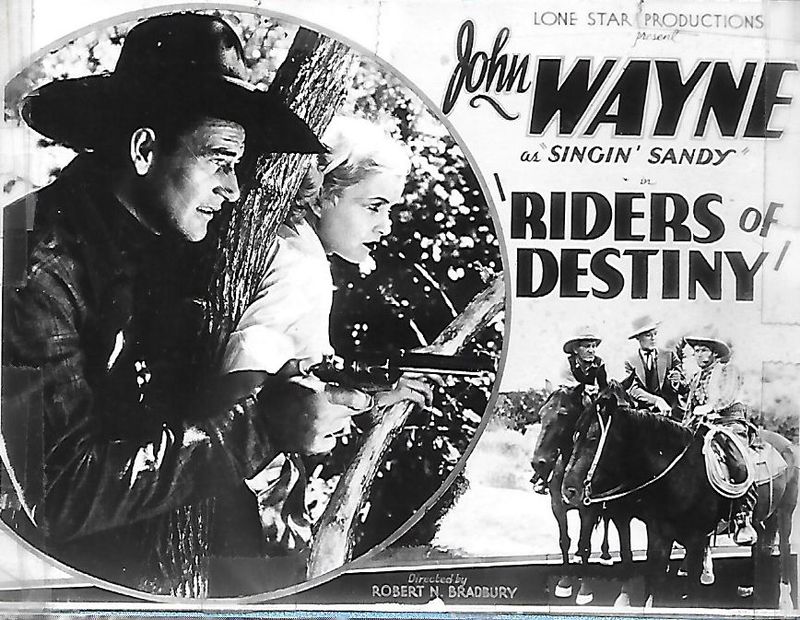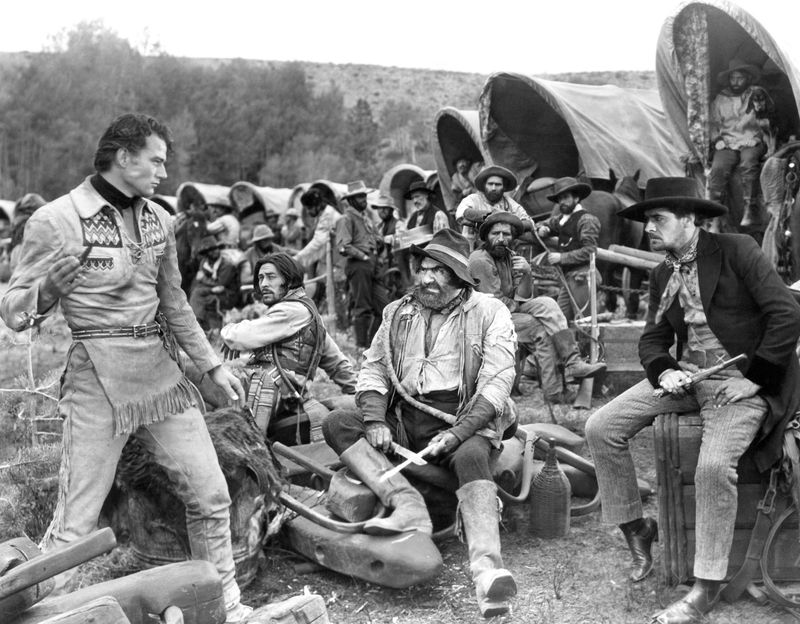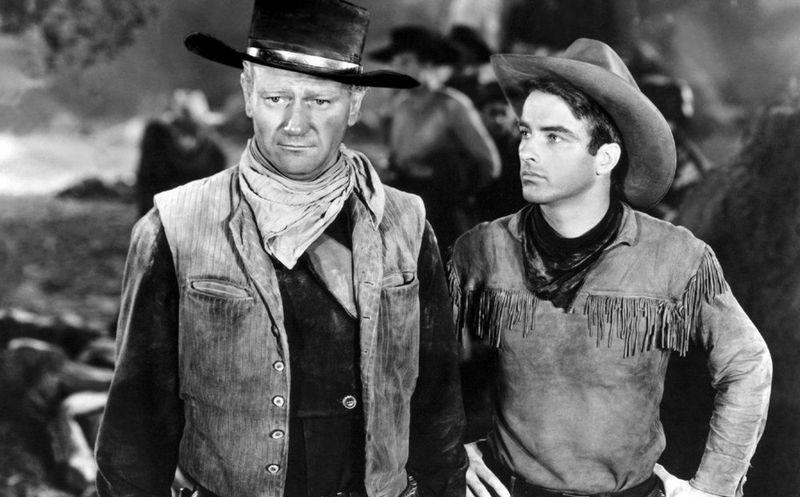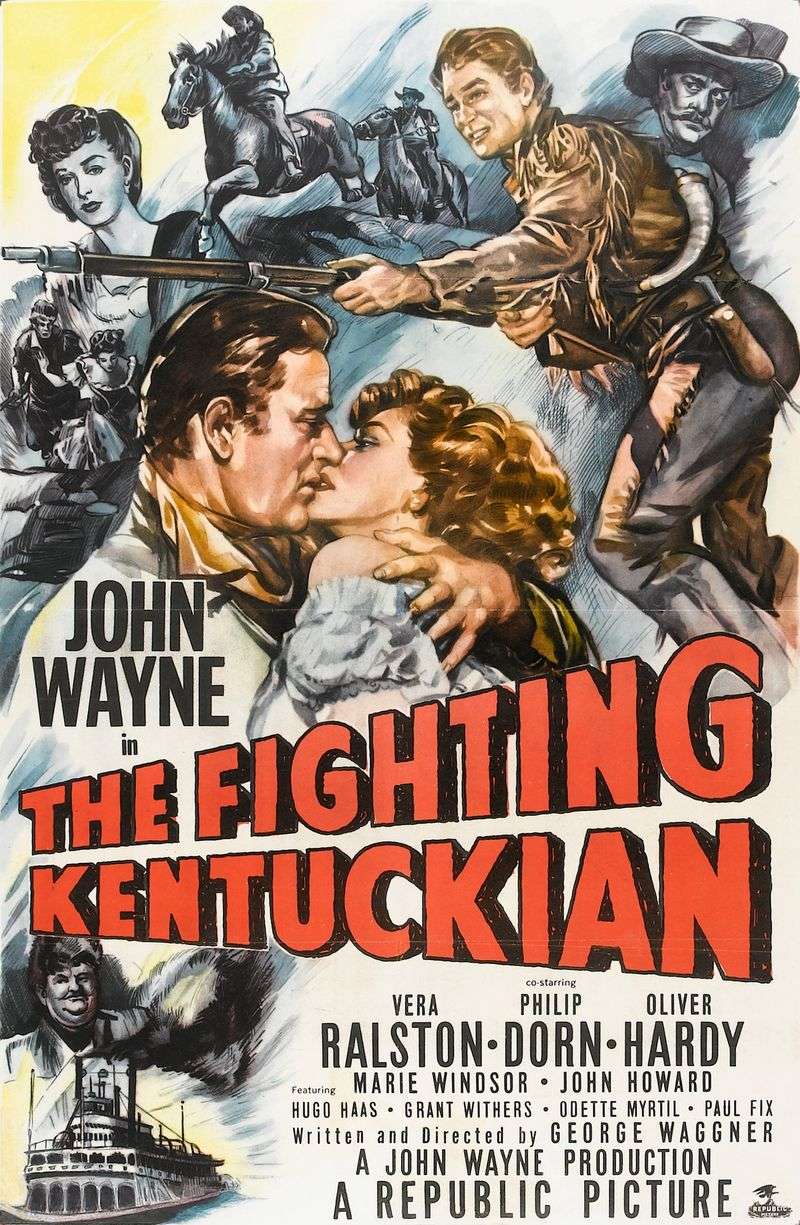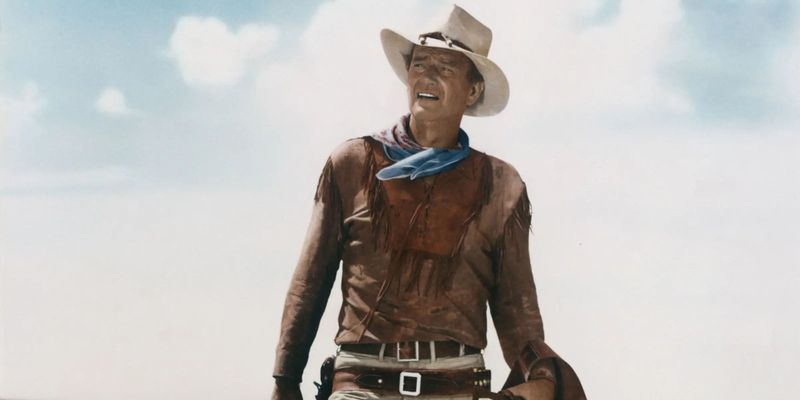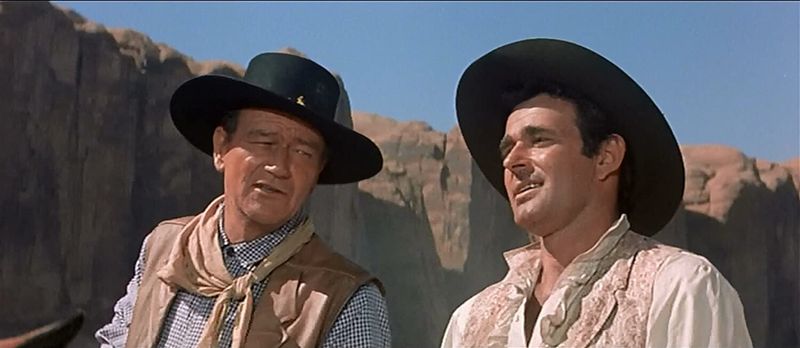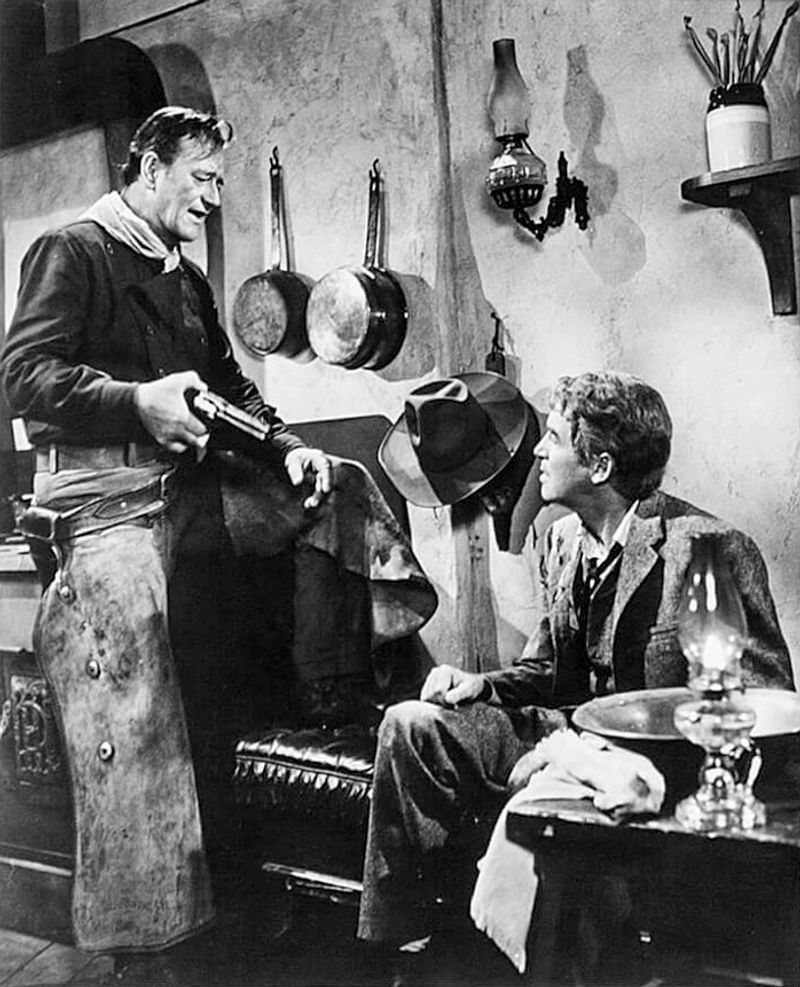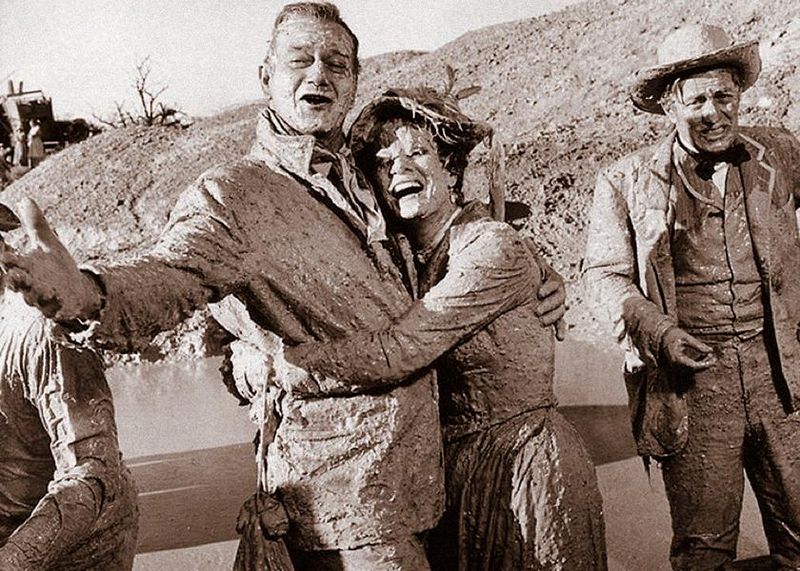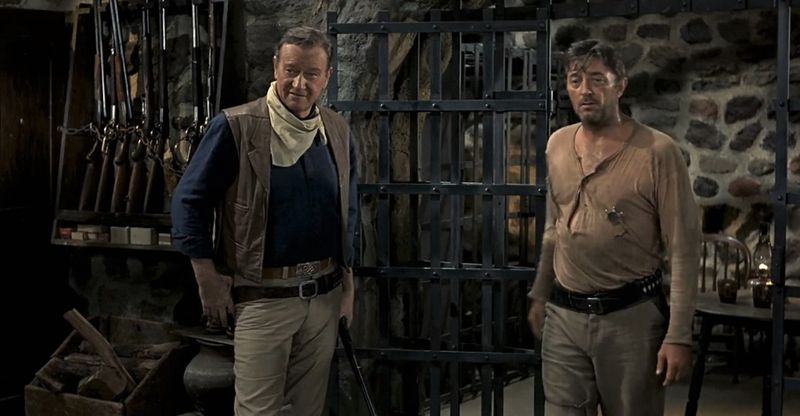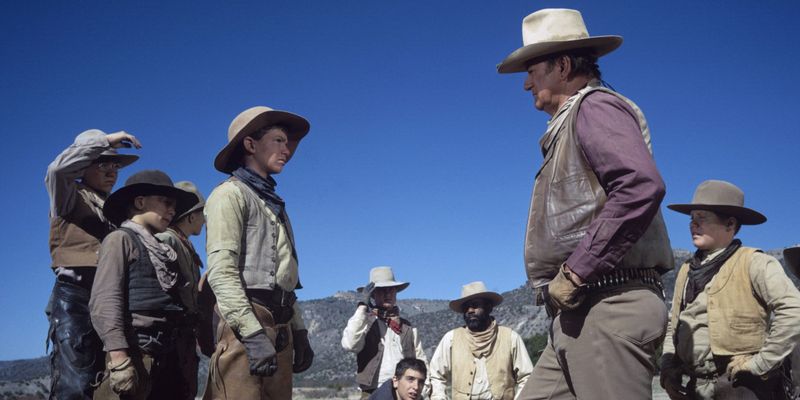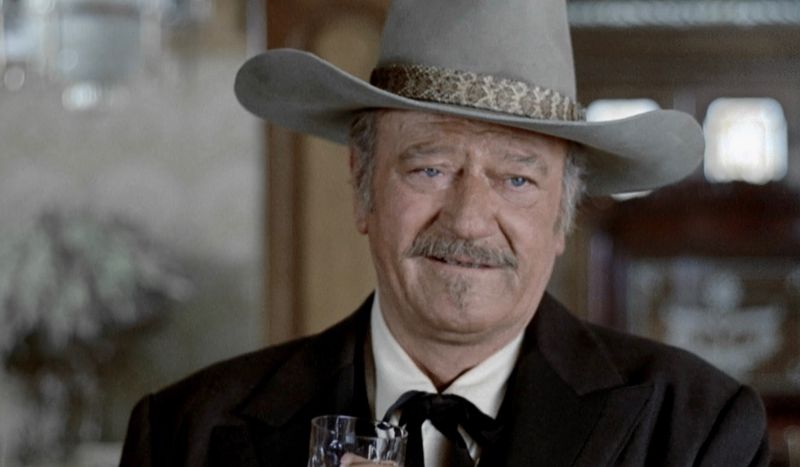John Wayne saddles up as the ultimate cowboy in countless Westerns, but not all his films got the spotlight they deserved. Behind the famous shootouts and one-liners lies a collection of underappreciated gems that shaped how we see the American frontier. These overlooked Westerns didn’t just entertain – they crafted our national identity, pioneered filmmaking techniques, and cemented Wayne’s legendary status.
1. Riders of Destiny (1933) – The Singing Cowboy Experiment
Galloping into theaters as a mysterious stranger with a secret mission, Wayne’s character ‘Singin’ Sandy Saunders’ surprised audiences with musical numbers (though Wayne’s singing voice was dubbed). This B-movie marked his first collaboration with director Robert N. Bradbury, establishing a partnership that would produce numerous Westerns.
Wayne portrays a government agent investigating water rights corruption in a drought-stricken town. His character’s dark, menacing demeanor contrasts sharply with his later heroic persona.
Despite its modest budget, the film showcases Wayne’s developing horseback skills and physical presence that would become his trademark. His performance balances both singing cowboy charm and intimidating gunfighter edge.
2. The Star Packer (1934) – Proto-Noir Western Mystery
Shadows and secrets dominate this early Wayne vehicle where he plays John Travers, a U.S. Marshal going undercover to expose a mysterious villain known only as ‘The Shadow.’ The film merges Western action with detective story elements, creating an unusual hybrid decades before genre-blending became fashionable.
Wayne’s character teams up with his Native American sidekick Yak (played by Yakima Canutt) to investigate a series of stagecoach robberies. Their partnership showcases a rare equal friendship between white and indigenous characters for 1930s cinema.
Director Robert N. Bradbury maximizes the limited budget with creative camera angles and moody lighting that anticipate film noir techniques. Wayne’s stoic performance hints at the screen persona that would later make him an American icon.
3. The Lawless Frontier (1934) – Vengeance Western Blueprint
Blood-soaked revenge drives this early Wayne vehicle where he hunts down Pandro Zanti, the half-breed outlaw who murdered his father. The film’s unflinching portrayal of frontier justice established themes Wayne would revisit throughout his career, most notably in ‘The Searchers’ decades later.
Director Robert N. Bradbury captures stunning desert landscapes on a shoestring budget, creating a visual template for countless Westerns to follow. Wayne performs his own dangerous stunts, including a breathtaking sequence where he leaps from his horse onto a moving wagon.
The film’s moral complexity surprises modern viewers expecting simple white-hat heroics. Wayne’s character walks a fine line between justice and vengeance, showcasing the moral ambiguity that would later define his greatest roles.
4. Tall in the Saddle (1944) – Mysterious Stranger Western
Arriving in town to discover his employer murdered, Wayne’s character Rocklin finds himself entangled in land disputes, family secrets, and unexpected romance. This mid-career gem bridges Wayne’s transition from B-movie cowboy to A-list star, showcasing his expanding dramatic range.
The film pairs Wayne with frequent co-star Ella Raines, whose feisty horsewoman character challenges gender norms of 1940s Westerns. Their chemistry crackles in scenes where she attempts to outshoot and outride him, creating a romantic subplot that feels surprisingly modern.
Director Edwin L. Marin crafts a mystery-western hybrid with noir elements, including an atmospheric night sequence where Wayne confronts killers during a thunderstorm. The film’s complex plot and morally ambiguous protagonist influenced countless Westerns that followed.
5. The Big Trail (1930) – Wayne’s Groundbreaking Debut
Shot in innovative 70mm widescreen when most theaters couldn’t even project it, this ambitious frontier epic marked Wayne’s first starring role at just 23 years old. Director Raoul Walsh spotted the young prop man and transformed him into a leading man overnight.
The film follows a wagon train’s perilous journey westward, capturing breathtaking vistas decades before ‘epic Westerns’ became popular. Though commercially unsuccessful, its revolutionary cinematography influenced generations of filmmakers.
Wayne’s raw performance hints at the screen presence that would later define American masculinity for decades. The film’s commercial failure relegated him to B-movies for nearly a decade before his triumphant comeback.
6. Red River (1948) – The Cattle Drive Masterpiece
Tyrannical cattle baron Thomas Dunson drives his herd and men to breaking point in this psychological Western that revolutionized Wayne’s career. Director Howard Hawks deliberately cast Wayne against type as an obsessive, increasingly unstable leader whose ruthlessness alienates even his adopted son (Montgomery Clift).
The film’s epic cattle drive sequences required months of shooting across dangerous terrain. Wayne insisted on performing his own riding stunts despite suffering a torn ligament during production, cementing his reputation for physical commitment.
Critics initially underestimated the film’s psychological depth and complex father-son dynamics. Modern filmmakers from Scorsese to Eastwood cite it as a primary influence, particularly its unflinching examination of how power corrupts even good men.
7. 3 Godfathers (1948) – The Christmas Western Fable
Three outlaws discover redemption in the desert when they become unlikely guardians of an orphaned infant. John Ford’s Technicolor Western reimagines the Biblical nativity story with bandits instead of wise men, creating a unique moral fable about second chances.
Wayne delivers one of his most vulnerable performances as Robert Marmaduke Hightower, a bank robber forced to confront his past sins. The scenes where his character awkwardly attempts to care for the baby reveal a tenderness rarely seen in Wayne’s tough-guy persona.
Ford’s breathtaking Monument Valley cinematography transforms the harsh desert into a spiritual testing ground. The film’s influence extends beyond Westerns, inspiring everything from ‘Three Men and a Baby’ to ‘The Mandalorian’ with its unlikely-guardian narrative.
8. The Fighting Kentuckian (1949) – Historical Frontier Romance
Fresh from the War of 1812, Kentucky rifleman John Breen (Wayne) discovers a settlement of exiled French soldiers and their families in Alabama. When he falls for a French general’s daughter, he becomes entangled in a land-grabbing conspiracy threatening the entire colony.
Wayne personally recruited his idol, silent film legend Oliver Hardy (without his comedy partner Stan Laurel), to play his sidekick Willie Paine. Their unexpected partnership creates a charming dynamic rarely seen in Wayne’s other Westerns, with Hardy providing both comic relief and surprising emotional depth.
The film blends historical drama, romance, and frontier action with unusually detailed period costumes and settings. Director George Waggner captures a fascinating moment in American history when French, Spanish, and American cultures collided on the frontier.
9. Hondo (1953) – The 3D Western Pioneer
Originally shot in 3D during Hollywood’s dimensional craze, this adaptation of Louis L’Amour’s story features Wayne as a half-Indian cavalry scout who protects a woman and her son from Apache warriors. The film’s nuanced portrayal of Native Americans was remarkably progressive for its era.
Wayne performs a spectacular knife fight with an Apache warrior that required weeks of training. His character’s complex relationship with indigenous culture creates moral depth rarely seen in 1950s Westerns.
Director John Farrow captures breathtaking Arizona landscapes with innovative 3D camera techniques. The film’s influence extends beyond its technical achievements, with its themes of cultural identity and found family later echoed in classics like ‘The Searchers’ and modern Westerns like ‘Yellowstone’.
10. The Comancheros (1961) – Buddy Western Adventure
Texas Ranger Jake Cutter (Wayne) reluctantly partners with gambler Paul Regret (Stuart Whitman) to infiltrate the Comancheros, dangerous gunrunners supplying weapons to Comanche raiders. Their odd-couple dynamic evolves from hostility to friendship across a series of increasingly dangerous adventures.
Michael Curtiz directed much of the film while battling terminal cancer, with Wayne quietly taking over directorial duties when Curtiz became too ill to continue. The film marks Curtiz’s final work, ending a legendary career that included classics like ‘Casablanca.’
The film’s blend of action, humor, and unexpected emotional moments created a template for buddy Westerns. Its influence extends to modern franchises like ‘Lethal Weapon’ and ‘Rush Hour’ that pair mismatched partners against dangerous criminal enterprises.
11. The Man Who Shot Liberty Valance (1962) – Western Mythology Deconstructed
“When the legend becomes fact, print the legend.” This iconic line encapsulates John Ford’s meditation on how the West was mythologized. Wayne plays Tom Doniphon, a tough rancher who secretly performs the heroic deed attributed to James Stewart’s eastern lawyer Ransom Stoddard.
Ford deliberately shot in black and white when color was standard, creating a stark, documentary-like quality. The film strips away Western romanticism, examining how civilization ultimately rejected the very frontier heroes who made it possible.
Wayne’s nuanced performance as a man who sacrifices his future for the greater good reveals depths rarely seen in his more straightforward heroic roles. The film’s examination of how history is constructed and manipulated feels increasingly relevant in our era of contested narratives and alternative facts.
12. McLintock! (1963) – Western Screwball Comedy
Cattle baron George Washington McLintock (Wayne) battles government agents, entitled homesteaders, and his estranged wife Katherine (Maureen O’Hara) in this raucous comedy. Their legendary off-screen chemistry ignites in their fifth film together, creating what many consider the Western version of ‘The Taming of the Shrew.’
The film features an infamous mud-wrestling scene where dozens of characters slide down a muddy hillside into a mining pit. This sequence required two weeks of filming and left the entire cast (including Wayne) covered in red clay that stained their skin for days.
Director Andrew V. McLaglen (son of Wayne’s frequent co-star Victor McLaglen) balances slapstick comedy with surprising social commentary about Native American rights. The film’s influence extends to later Western comedies like ‘City Slickers’ and ‘Shanghai Noon.’
13. The War Wagon (1967) – Western Heist Thriller
Rancher Taw Jackson (Wayne) teams with his sworn enemy Lomax (Kirk Douglas) to steal gold from the heavily-armored stagecoach—the “war wagon”—owned by the man who stole his land. Their unlikely partnership creates crackling dialogue and tense moments as neither fully trusts the other.
The film pioneered the Western heist subgenre, combining traditional frontier action with elaborate robbery planning sequences. Director Burt Kennedy stages an innovative climactic chase featuring the titular war wagon—an armored stagecoach equipped with a Gatling gun and steel plating.
Wayne and Douglas share remarkable chemistry despite their political differences off-screen. Their witty banter influenced countless action buddy films, from ‘Butch Cassidy and the Sundance Kid’ to ‘Ocean’s Eleven,’ proving that enemies can become effective partners when gold is involved.
14. El Dorado (1966) – The Friendship Western
Gunfighter Cole Thornton (Wayne) supports his alcoholic friend Sheriff J.P. Harrah (Robert Mitchum) against a ruthless cattle baron. Director Howard Hawks essentially remade his earlier ‘Rio Bravo,’ creating an unofficial trilogy completed by ‘Rio Lobo,’ each examining themes of loyalty and redemption.
Wayne insisted on performing a dangerous stunt where he falls backward off a horse despite having suffered a broken shoulder and punctured lung on a previous film. The scene required multiple takes, worsening his injuries and contributing to his chronic pain in later years.
The film’s portrayal of aging heroes facing physical limitations—Wayne’s character suffers from a bullet near his spine while Mitchum battles alcoholism—resonated with audiences during the Vietnam era. Its unflinching look at friendship between damaged men influenced everything from ‘Unforgiven’ to ‘No Country for Old Men.’
15. The Cowboys (1972) – Coming-of-Age Western Drama
When all the adult cowhands leave for gold prospecting, aging rancher Wil Andersen (Wayne) reluctantly hires eleven schoolboys for his cattle drive. What begins as a desperate business decision evolves into a powerful mentorship as Andersen transforms the boys into men.
The film shocked audiences with its unexpected violence, particularly the brutal scene where villain Long Hair (Bruce Dern) murders Wayne’s character. Dern received death threats for years after killing America’s beloved cowboy hero on screen.
Director Mark Rydell insisted the young actors perform their own dangerous stunts, including bronco riding and cattle herding. The film’s unflinching portrayal of the loss of innocence and the price of manhood influenced later coming-of-age stories from ‘Stand By Me’ to ‘Dead Poets Society.’
16. Cahill U.S. Marshal (1973) – Father-Son Western Drama
Legendary lawman J.D. Cahill (Wayne) tracks bank robbers only to discover his own neglected sons were involved in the crime. The film examines the painful consequences when duty to the law conflicts with responsibilities to family.
Wayne’s performance as a father confronting his parental failures reveals surprising vulnerability in his typically stoic screen persona. Director Andrew V. McLaglen captures the psychological tension through stark landscapes that mirror the emotional distance between father and sons.
The film’s unflinching portrayal of parental neglect was informed by Wayne’s real-life regrets about his relationships with his children during his early career. Its exploration of how violence and law enforcement trauma affect families has influenced modern crime dramas from ‘Breaking Bad’ to ‘Mare of Easttown.’
17. The Shootist (1976) – Wayne’s Poignant Farewell
Dying gunfighter J.B. Books (Wayne) seeks a dignified end in turn-of-the-century Carson City as newspaper reporters, old enemies, and opportunists discover his presence. The parallels between Books’ terminal cancer and Wayne’s own health struggles (he had lost a lung to cancer years earlier) create a meta-narrative that transcends the Western genre.
Director Don Siegel creates a elegiac tone through period-accurate sets and golden-hour cinematography. Wayne’s interactions with James Stewart, Lauren Bacall, and Ron Howard connect multiple Hollywood eras, creating a living cinematic history.
Wayne chose this role as his final performance, knowing its meditation on legacy and dignity in death would serve as his screen farewell. The film’s exploration of how legends face mortality has influenced countless final chapters, from ‘Logan’ to ‘Unforgiven.’

